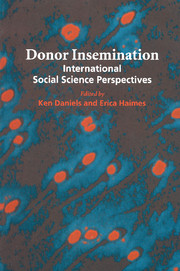Book contents
- Frontmatter
- Contents
- List of figures
- List of tables
- Notes on contributors
- Acknowledgements
- List of abbreviations
- 1 International social science perspectives on donor insemination: an introduction
- 2 The users of donor insemination
- 3 Families created through donor insemination
- 4 The making of ‘the DI child’: changing representations of people conceived through donor insemination
- 5 The semen providers
- 6 The medical management of donor insemination
- 7 Regulation of donor insemination
- 8 Donor insemination and ‘public opinion’
- 9 Concluding comments
- Index
6 - The medical management of donor insemination
Published online by Cambridge University Press: 04 August 2010
- Frontmatter
- Contents
- List of figures
- List of tables
- Notes on contributors
- Acknowledgements
- List of abbreviations
- 1 International social science perspectives on donor insemination: an introduction
- 2 The users of donor insemination
- 3 Families created through donor insemination
- 4 The making of ‘the DI child’: changing representations of people conceived through donor insemination
- 5 The semen providers
- 6 The medical management of donor insemination
- 7 Regulation of donor insemination
- 8 Donor insemination and ‘public opinion’
- 9 Concluding comments
- Index
Summary
Introduction
Medical assistance with conception cannot be explained away as merely another technical achievement due to progress in biology and medicine. An unorthodox approach to the problem of infertility, it has radically altered the usual framework of bodily practices and social relationships which organise and give meaning to reproduction in our society. Until two centuries ago, a birth had always been the result of sexual intercourse between two persons of the opposite sex, whose relationship was already (or, as a consequence of this event, would come to be) defined in familial terms. The use of assisted conception transfers the act of fertilisation to a medical setting, where relationships are primarily defined in therapeutic terms, where predominant values concern the quality, security and efficiency of a technical act, and where the physician is held responsible for the appropriate management of medical procedures. Decisions are now being made about childbearing in a context which dissociates issues relating to fertility and the family from sexual intercourse.
The more recent extracorporeal technique known as in vitro fertilisation has made it seem obvious that assistance with conception necessarily involves medical intervention: without physicians to monitor hormonal stimulation, perform laparoscopy or ultrasound probes for oocyte retrieval, and place in vitro fertilised embryos within the uterus, such a technique would in fact not be possible. However, the much older and simpler technique, known as artificial insemination does not require such medical intervention: it is fairly simple to find the adequate instrumental means for transferring semen to the vagina.
- Type
- Chapter
- Information
- Donor InseminationInternational Social Science Perspectives, pp. 105 - 130Publisher: Cambridge University PressPrint publication year: 1998
- 26
- Cited by



